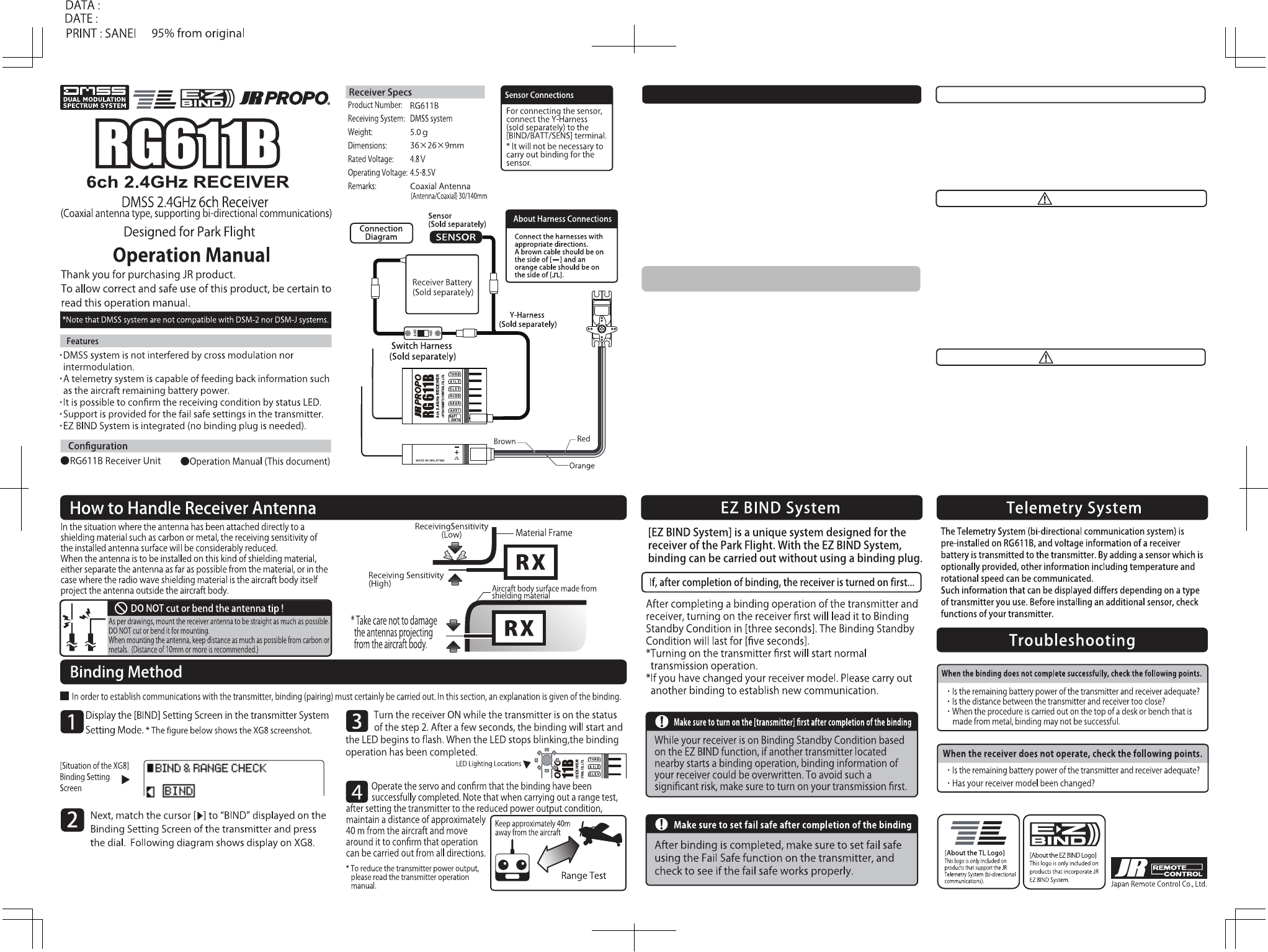Konishi Mokei RG611B Radio Control Receiver User Manual RG611B manual E C
JAPAN REMOTE CONTROL CO., LTD. Radio Control Receiver RG611B manual E C
User Manual

In order to protect against injury to users or third parties, or damage to
property, points that must certainly be observed are shown below.
■Please Read Before Use
To allow safe use, be certain to observe the following points.
●Basic Precautions for Safe Use of the 2.4GHz System
(1) The 2.4GHz band is not a frequency exclusively for use with RC airplanes. This
frequency band is in common use with the ISM (industry, science, and medical
care) band which is widely used for short-distance transmissions such as
microwave ovens, wireless LAN, digital cordless phones, audio, gaming
devices, cell phone Bluetooth. Therefore, the response of the 2.4GHz system
may be reduced in urban areas. Further, as it also is used for ham and local area
radio communication for mobile identification, please pay attention to the
possible influences from these. In the event of any adverse radio wave
interference on an existing wireless station, immediately stop emitting radio
waves and take the interference avoidance measures.
(2) At race tracks and airfields, minimize the use of devices that can affect the
transmitter/receiver and be sure to confirm the safety beforehand. Also, always
follow the instructions of the facility staff.
(3) If an aircraft is allowed to pass behind a building, pylon, trees, etc. the
radio-wave range is blocked, the response may drop, even result in losing
control. Always let aircraft run or fly within a range that you can visually
observe.
This device complies with Part 15 of the FCC Rules. Operation is subject to the following two conditions:
(1) this device may not cause harmful interference, and (2) this device must accept any interference received,
including interference that may cause undesired operation.
Warning: Changes or modifications to this unit not expressly approved by the party responsible for compliance
could void the user's authority to operate the equipment.
NOTE: This equipment has been tested and found to comply with the limits for a Class B digital device, pursuant
to Part 15 of the FCC Rules. These limits are designed to provide reasonable protection against harmful
interference in a residential installation. This equipment generates, uses and can radiate radio frequency energy
and, if not installed and used in accordance with the instructions, may cause harmful interference to radio
communications.
However, there is no guarantee that interference will not occur in a particular installation. If this equipment does
cause harmful interference to radio or television reception, which can be determined by turning the equipment
off and on, the user is encouraged to try to correct the interference by one or more of the following measures:
1. Reorient or relocate the receiving antenna.
2. Increase the separation between the equipment and receiver.
3. Connect the equipment into an outlet on a circuit different from that to which the receiver is connected.
4. Consult the dealer or an experienced radio/TV technician for help.
This device complies with Industry Canada Licence-exempt RSS-210. Operation is subject to the following two
conditions: (1) this device may not cause interference, and (2) this device must accept any interference,
including interference that may cause undesired operation of the device.
DANGER!
WARNING!
CAUTION!
Not following this advice carries high risk of death or serious injury to
the user or third parties.
Not following this advice may result in death or serious injury the user
or third parties.
● Do not use this product in the rain as water may cause electronic devices to malfunction.
● This product carries a risk of injury due to heat, fire, and electric shock.
● Never disassemble or modify this product.
● When turning on the receiver, the engine (or motor) can start rotating at high speed,
causing injury.
● Before turning on, always set the transmitter throttle stick to the lowest speed position.
Turn on the transmitter first then the receiver.
To shut down, switch off the receiver first and then the transmitter.
Not following this advice may cause injury to the user or third party (or
cause damage to property).
■If you have further questions, please contact your local dealer or JR distributor in your country.
●Is there enough battery voltage for both the transmitter and receiver?
●Is there any fuel spillage on the receiver, servos, etc. that was caused by leakage from the fuel
tank? Is there enough fuel?
●Check that no linkage interferes with the aircraft body. Conduct a vibration test by restraining
the model and setting the engine (or motor) to full power whilst keeping your hands well
clear of the propeller. Check that each control surface moves correctly. For the initial flights of
a new model always fly in a safe place, avoid flying at great distance, and keep the model
close to the landing area for several minutes until you are fully confident that the receiver is
operating correctly.
● Do not use this receiver in combination with other manufacturers products such as servos,
gyros etc.
● Never allow the receiver to receive a strong impact as the electronic components in the
receiver are susceptible to damage.
● If degraded servo movement is detected, stop operating immediately. Identify the source
of the problem before further operation (check battery voltage, etc).
● Do not use the product in the following locations, as there will be a risk of an out-of-control
condition or accident:
• Where interference exists. • Where there is traffic passing nearby.
• Near high-tension electric lines, buildings, or in mountainous areas, etc.
• Near houses or people. • Near radio or TV transmitters
● If the receiver becomes submerged in water, it may appear to operate normally after being
fully dried. However, it may malfunction at a later time. Do not continue to use the product
‒ contact your JR distributor to arrange an inspection.
2014.02.06
RG611B_manual_rev.C